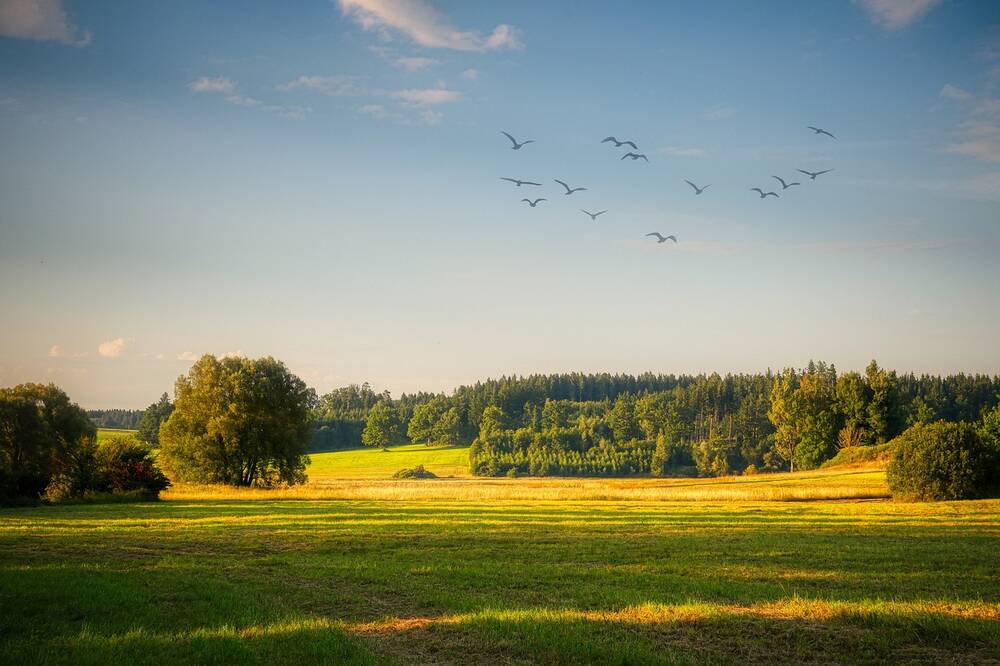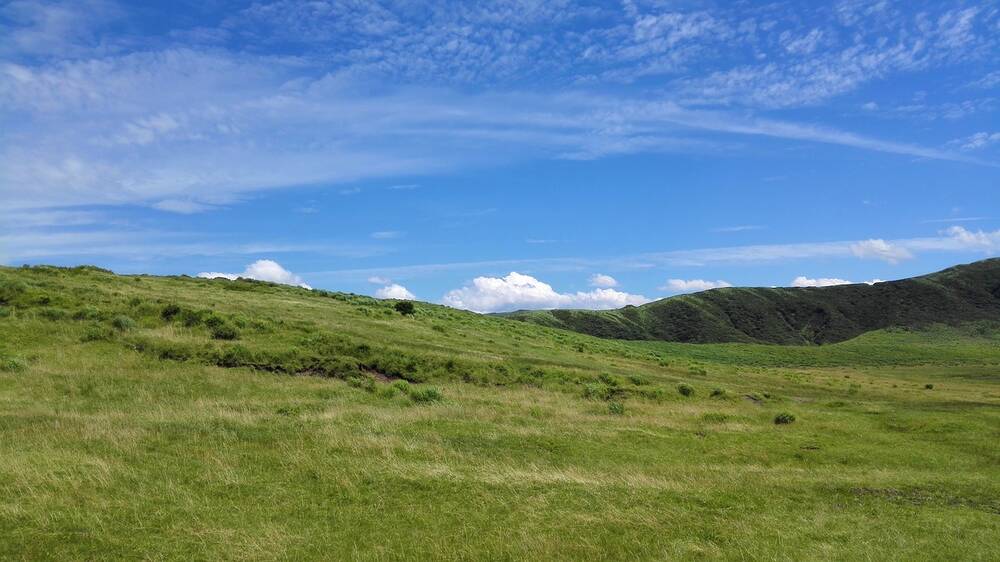Grassland habitats occur across the UK in a variety of habitats, each with unique biodiverse ecosystems offering rare ecological value and supporting ranges of wildlife. They are crucial for our climate and regulating ecosystem services such as carbon sequestration. Beyond the UK, there are numerous types of grassland habitats utilising many different regions across the world. This post delves into the various types of grassland habitats in the UK and worldwide, key facts and figures, their key features, their history, their specialised ecological values, their threats and efforts for conservation, as well as their flora and fauna inhabitants.
What are Grassland Habitats?
Grassland habitats are very common in the UK, consisting of treeless, open areas that are packed with grasses and wildflowers, supporting a diverse range of wildlife and crucial for biodiversity.
The wildflowers are key for pollinators, and the ecosystems are key for carbon sequestration and maintaining healthy soil.
They appear in upland and lowland areas and can be wet and dry.
The habitats are easily maintained by the grazing of horses, sheep, cattle or other livestock, keeping plants diverse by controlling dominant species, and mechanical mowing of the plants to prevent trees and shrubs.
Key Features of Grassland Habitats
There are various types of grassland habitats, and each may boast unique features, however, all follow an overarching pattern.
They typically have high flora and fauna biodiversity, being dominated by dense grasses and herbaceous plants. Rare plants are often found due to unique ecological conditions.
The plant growth varies by season, as the dynamic environment provides resource diversity-supporting ranges of wildlife throughout the year.

The Different Types of Grassland Habitat
While the UK supports a distinct range of grassland habitats, there are many interesting types of grassland habitats around the world, from the Montane Grasslands in the Rockies in North America to Xeric Grasslands in the southwestern United States.
Temperate Grassland
These once covered around 40% of the Earth’s land, but has since largely been used for agricultural purposes.
Temperate grassland habitats are categorised by their hot summers, cold winters and moderate periods of rain. They are most prevalent in the Great Plains of North America, South America, and Eurasia. They are typically not found in the UK.
They are home to mammals like bison and prairie dogs, and birds like meadowlarks and hawks, alongside the dominating blue grama and buffalo grass.
Ecologically they boast high soil fertility, with rich biodiversity supported by herbivore grazing. They’re threatened by frequent fires.
Steppe
Also not common in the UK, steppe grasslands are predominantly in the great Eurasian Steppe, reaching from Hungary into Ukraine, through Russia, Mongolia and into China.
It’s one of the largest continuous biomes in the entire world, boasting an enormous length of around 8,000 kilometres.
Its open, treeless landscapes grow within a semi-arid climate (hot or very hot summers, and cool or warm winters). It has a less intense rainy season, home to the dominating feather grass, ranges of wildflowers, the saiga antelope, marmots and steppe eagles.
Prairie
Most common in Central North America and not occurring in the UK, prairie grasslands vary into several types, detailed further in this post.
Prairie habitats are resilient to fire, with deep root systems and rapid regrowth periods. This is because fire maintains their ecosystem by depleting the woody plants that threaten to outcompete the prairie grasslands.
Meadow
Meadows are widely common throughout the UK, also appearing frequently in Europe and North America. They’re often found near water or with heavy rain, utilising dynamic water regimes, and support many grasses, and wildflower meadows supporting clovers and daisies, birds, bees and butterflies.
Their high plant diversity makes them key for pollinators, offering beautiful scenes throughout spring and summer. They are usually maintained by mowing and grazing, making sure that no trees grow and disrupt the ecological balance.
Floodplain Grassland
Found in the UK and worldwide alongside riverbanks, floodplain grasslands support rich biodiversity by maintaining nutrient-rich soils in periodically flooded areas.
These rich grasslands can help maintain water purification and keep floods in control. In the UK, they tend to display the reed canary, meadow foxtail and common bent species of grass, wildflowers such as the marigold, and aquatic plants such as the water mint or yellow flag iris.
We also have frogs, newts, water voles and otters as regular residents within floodplains.
Montane Grassland
Montane grasslands are primarily found in mountain regions, such as the Andes, the Alps or the Rockies, but also in the Scottish Highlands.
They feature steep mountain-side terrain at high altitudes with ranging microclimates, adapted to colder climates and resilient against drastic temperature variations. The habitats are home to shrubs, wildflowers, and hardy grasses, alongside mountain goats, elk and birds of prey.
Desert Grassland
Desert grasslands occur in arid, or very dry, regions, like areas in Mexico or the southwestern United States.
They tend to be transitional zones, between temperature regions and true deserts and have sandy or rocky soil supporting succulents, shrubs or cacti. Galleta, blue grama and other drought-resistant grasses dominate the habitats where water is scarce.
Animals in these habitats could be the kangaroo rat, which collects moisture from seeds, the pronghorn antelope who can travel fast and quickly to source food and water.
Tussock Grassland
Tussock grasslands occur in New Zealand, parts of Australia and not in the UK, distinguished by dense clumps of grass called tussocks which keep soil stabilised and prevent erosion.
Tussocks provide shelter for ground-nesting birds, insects and smaller mammals, and create a mosaic of distinct microhabitats leading to rich biodiversity in plant and animal life. They tend to indicate ecosystem health, with effective water retention and stable soil structures.
Alpine Grassland
Found in regions like the Alps, the Himalayas, and the Scottish Highlands, alpine grasslands favour harsher, mountainous climates with strong winds, lower temperatures and shorter periods for growth.
This growth period means habitats are packed with low-growing grasses, alongside sedges, and animals like marmots, ibex or alpine choughs in the Alps. In Scotland, you might see the ptarmigan bird, mountain hare, snow bunting, golden eagle or red deer.
The adaptive animals and specialised vegetation are fit for extreme weather conditions and rocky environments.
Coastal Grassland
Coastal grassland habitats populate the UK’s coasts, including coastal meadows, dune grasslands, machair or salt marshes. There are also many dune systems in the Netherlands.
The natural environment’s coastal winds, saline levels and tidal floodings promote salt-tolerant species, like sea lavender, crabs, shorebirds, saltmarsh sparrows or cordgrass.
The periodic inundation creates a dynamic environment, resulting in a buffer zone that protects land from storm surges or erosion.
Xeric Grassland
Xeric, derived from the Greek word “xeros” means dry, and xeric grasslands are those partial to extremely dry environments, appearing largely in the southwestern United States.
The habitats require their flora and fauna to manage water scarcely, such as desert tortoises, coyotes, kangaroo rats and drought-resistant grasses.
Their soil quality is poor, and home to specialised nature used to extreme conditions. Areas tend to be sparsely vegetated with extensive areas of bare rock or soil.
Peat Grassland
Peat is an accumulation of organic matter, partially decomposed over thousands of years, with layers of moss, heather or grass, providing many precious biodiverse habitats around Scotland and Ireland.
The acidic soils with high-water retention support bog and sphagnum mosses, snipe and curlew birds, varied dragonflies and unique plant communities. They are fantastic carbon sinks, often with open patches of water.
Heath Grassland
Heath grasslands occur predominantly within heathland regions, common in the UK such as in the New Forest, as well as part of Scandinavia like Southern Norway and Western Sweden.
They predominantly support heather, plus the gorse plant, the Dartford warbler bird, the heath tiger beetle and the European adder.
Acidic, low-nutrient and sandy soils provide distinctive vegetation, resulting in a mixed open and scrubby landscape.
Urban Grassland
Urban grasslands occur in cities and towns across the world, including brownfield sites or urban parks in the UK. These widely modified environments tend to have ranging microclimates with a variable quality of soil.
Species tend to mix between native and non-native, with urban-adapted wildlife like pigeons, with scavenging techniques and building utilisation for nesting, and foxes who are highly human-tolerant, come out at night and can take a flexible diet.
Mixed Grass Prairie
Mixed grass prairies are combinations of tall and short grasses, with variable soil and moderate rainfall.
They appear most in Central North America, such as in parts of the Great Plains. The diverse grass heights provide a mosaic of various habitats, critical for many migrating birds as well as key grazing land for livestock.
Shortgrass Prairie
The shorter grass prairie habitat appears more in the Western Great Plains, as well as Kansas, Colorado and Wyoming. Their low rainfall climate comes alongside frequent droughts with resilient short grasses supporting unique wildlife that is well-adapted to dry environments.
Tallgrass Prairie
The tallgrass appears in the Eastern Great Plains, as well as Oklahoma, Kansas and Nebraska. These have fertile soils with high rainfall and healthy tall grasses, up to 8 feet tall!
The rich soil results in a lush, dense and biodiverse environment with tall vegetation, however fertile soils are largely under threat from farmland, making it a highly endangered ecosystem.
Animals That Live In Grassland Habitat

Grassland habitats are homes to a variety of animals that have adapted to the open landscapes, seasonal changes, and varying availability of food and water, overall contributing to complex and rich ecosystems.
Mammals enjoy the open environments that provide places to hide from predators, conventionally amongst abundant vegetation and feeding grounds, which could be bison, zebras, lions or antelope.
Varieties of birds are supported by each distinct grass habitat and its ecological features, from ostriches to prairie chickens, as well as rattlesnakes, toads, and different reptiles and insects.
The ten most common animals that live in grassland habitats are:
Bison
- Pronghorns
- African Elephants
- Lions
- Cheetahs
- Prairie Dogs
- Kangaroos
- White-tailed Deer
- Zebras
- Antelopes
Plants & Flowers
The beauty of open grassland landscapes lies in the flourishing of unique and rare wildflowers, which support a biologically diverse ecosystem.
The key foundations for grassland wildlife are grasses such as the Red Fescue and the Common Bent, key structural foundations for habitats and resilient to grazing with a quick regrowth period.
Plants found include wildflowers such as the meadow buttercup, cowslip or oxeye daisy, providing colourful displays and support pollinators, and herbs such as the yarrow and the common knapweed, encouraging nitrogen-fixing bacteria that enrich the soil.
Threats & Conservation
Grassland habitats are largely threatened by agriculture, offering rich habitats that can easily be utilised for farming, livestock, silage or pasture purposes.
Another key threat is climate change and pollution.
Urban development also poses a risk as grasslands’ open landscapes can be ideal for new builds—however Biodiversity Net Gain ensures that any habitats and biodiversity lost in development must now be restored either onsite or off-site through purchasing BNG units (such as via our BNG Marketplace).
Development can lead to habitat fragmentation which disrupts the stability of ecosystems and counters their resilience.
Furthermore, afforestation is when trees are planted in grassland areas, leading to declines in native plant species, habitat disruptions and light and water reductions.
The History of Grasslands
Having evolved from the last Ice Age, grasslands grew from open landscapes leftover from the glaciers. They were first utilised by farmers around 4000 BC, where their agricultural understandings began.
They were key to rural life in the Medieval Period and were often transformed into farming lands in the 18th and 19th Centuries.
The Industrial Revolution heightened pressures on agriculture, enhancing production, which incorporated technological advances during the 20th Century. Habitat degradation and grassland loss ensued following an overload of intensive farming.
Mid 20th Century widespread biodiversity loss encouraged awareness, and conservation movements alongside environmental policies have aided grassland restoration on a mass scale.
Grassland Habitats Facts & Stats
Interestingly, around 40% of the UK’s land consists of grassland habitats — such as upland pastures, chalk grasslands and lowland meadows.
Within a century we’ve lost more than 97% of species-rich grassland in England and Wales. These were widespread, high biodiversity and unique plant communities, bursting with pollinators, birds, mammals and buzzing wildlife.
It’s common that UK grasslands will be SSSis (Sites of Special Scientific Interest) which means that they are legally protected, with mandated management requirements. They are well funded and will be regularly monitored, ensuring the habitats are happy.
More Information
https://www.wildlifetrusts.org/habitats/grassland
https://www.woodlandtrust.org.uk/trees-woods-and-wildlife/habitats/grassland
https://www.plantlife.org.uk/protecting-plants-fungi/grassland

